Ultrashort pulse widths and higher peak powers are the hallmarks of today’s solid-state lasers suited for welding circuit boards and cutting sheet metal.
For solid-state lasers, more power, along with increasingly robust systems and a wider variety of wavelengths, mean new applications in cutting, welding, precision manufacturing, marking and elsewhere. Together with falling prices, such advances are putting lasers into new applications. On the horizon are solid-state lasers that enable high-resolution x-ray, neutron and electron imaging for nondestructive testing of turbine blades, engine parts and other components.
Those systems and capabilities lie in the future. Today, solid-state lasers come in two broad categories. The first is continuous wave or systems with long pulse widths of a microsecond or more. The second group has ultrashort pulse widths that are nanoseconds or less. For both laser types, power output is increasing.
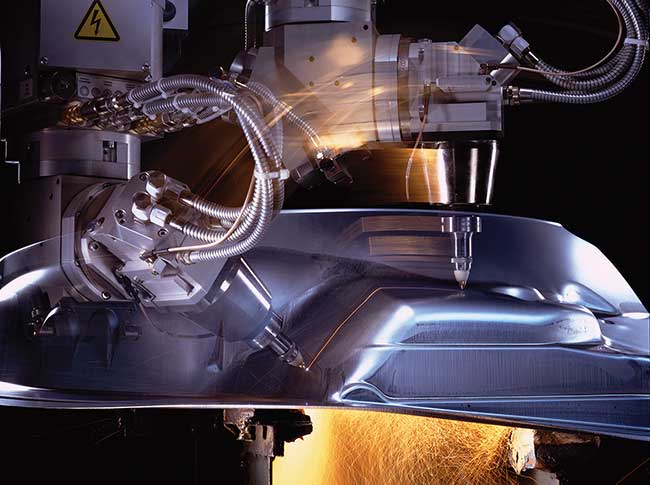
With increasing power, solid-state lasers enable faster materials processing. Courtesy of Trumpf.
For instance, the Trumpf Group of Ditzingen, Germany, makes disk lasers, which are continuous or quasi-continuous in operation.
“For sheet metal cutting right now, we are looking into eight- to 10-kilowatt lasers,” said Sebastian Zaske, product manager of high-power lasers.
That is an order of magnitude more power than the first disk laser of 20 years ago, he said. What’s more, current systems deliver this energy via a 100-micron-diameter fiber instead of using bulky free-space optics. That speeds up material processing and boosts throughput.
“You can bring the power to the workpiece through the fiber and you have no problem to move this around,” Zaske said.
Disk lasers allow power scaling by increasing the pump area on the crystal disk, with even greater power possible by using two or more disks instead of one. In either case, engineering work must be done so that the power can be delivered to the work surface as efficiently as possible, Zaske said.
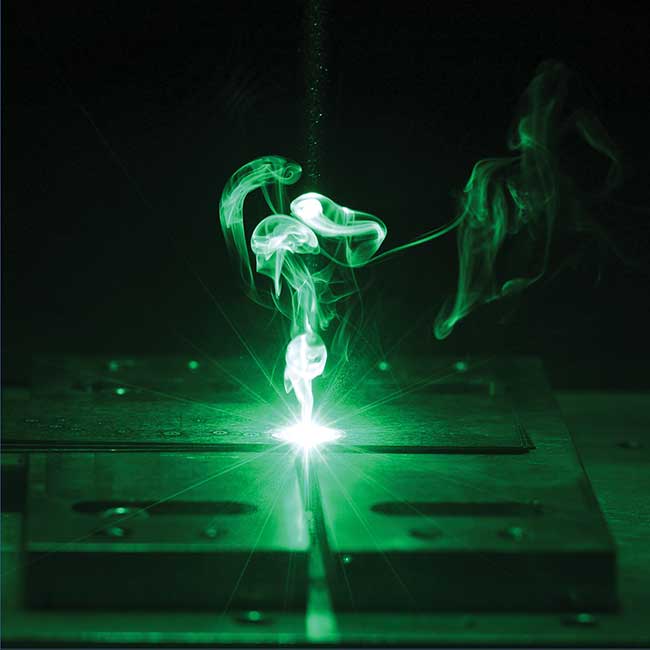
Courtesy of Trumpf.
Trumpf’s disk lasers output light at 1030 nm and the company is now delivering products that double that fundamental to 515 nm. Light in the green makes it easier to process copper, particularly welding and cutting the thin layers often used in electronic printed circuit boards, Zaske said. Using such lasers with 10-millisecond-wide pulses leads to less spatter and thereby improves circuit board reliability, making these green disk lasers attractive for this application, he added.
Pulsed fiber lasers
Besides disk lasers, the other solid-state system widely used now in commercial materials processing is fiber lasers, with both continuous and pulsed versions available. The second variety is one of the lasers of choice for the Alltec Laser Business Unit of Selmsdorf, Germany. The company makes equipment that marks parts with a 2D barcode and other information.
Peter Kückendahl, Alltec senior director for engineering research and development, noted that in this application, having as short a pulse width as possible for some materials is critical because it improves the clarity of the mark. It also reduces any slag and thereby cuts down on the post-processing cleanup needed.
Fortunately, advances in solid-state laser pulse widths are leading to systems that are better suited for manufacturing
applications where margins are constrained. “Pulses are getting shorter at a reasonable cost,” Kückendahl said. “Many fiber laser companies are working on picosecond lasers.”
Moving into an ultrashort pulse width regime can naturally lead to higher peak power, according to Florent Thibault, product line manager for high-power industrial picosecond lasers at Coherent Inc. of Santa Clara, Calif. That happens if the pulse energy remains the same or nearly the same while the pulses get shorter.
Laser system makers have an incentive to make sure this peak power rise happens, Thibault said.
“It drives higher accuracy. These lasers are entering the factory floor and customers want also to get throughput, simply to minimize the cost per part that they are producing.”
A decade ago, the maximum power of such an ultrashort-pulse-width laser was measured in watts. Today, systems topping a hundred watts are routinely sold, and within the next few months even higher-power systems will ship, Thibault said. He added that over the past 10 years, the cost to deliver a watt of power has been reduced by 80 to 90 percent and could soon reach a dollar a watt.
As for wavelengths, the highest power level is at 1064 nm, the fundamental wavelength. This can be doubled to get
a green output at 532 nm and tripled to get output in the ultraviolet at 355 nm. Going down in wavelength complements shortening the pulse width in terms of materials processing, as both can minimize the impact on surrounding material and that can lead to a more precise manufacturing.
Increasing throughput
Another trend cited by Thibault concerns the integration and synchronization of the laser system with the rest of the manufacturing process. Advanced triggering capabilities allow a further increase to throughput, reducing the cost per part, while still delivering micron-level accuracy expected in the high-end manufacturing enabled by ultrashort-pulse-width lasers, according to Thibault.
Further significant cost cutting for some categories of ultrafast solid-state lasers are possible. These could be accompanied by an order-of-magnitude increase in power.
For instance, KMLabs Inc. of Boulder, Colo., has just started shipping a direct diode-pumped Ti:sapphire femtosecond laser system. According to CEO Henry Kapteyn, this advance is possible because commercial single-emitter blue diode lasers are now powerful enough to pump the Ti:sapphire.
“Instead of using a $30,000 to $50,000 five-watt green laser, we can use a laser diode at a cost of less than $100. So, it’s a pretty dramatic cost reduction,” Kapteyn said.
He added that the same diodes will also enable the scaling up of Ti:sapphire power by a factor of 10 or more, in particular for the widely used high peak-power Ti:sapphire amplifier systems. If higher power can be achieved economically, it opens up additional applications.
Researchers are also investigating how to up the peak power of ultrashort-pulse-width fiber lasers, with an example being work done by a team from Cornell University in Ithaca, N.Y. In a 2017 Optica paper titled “Megawatt peak power from a Mamyshev oscillator,” the group reported on an environmentally stable design that offered at least an order-of-magnitude higher peak power than reported previously by lasers of similar fiber mode area.
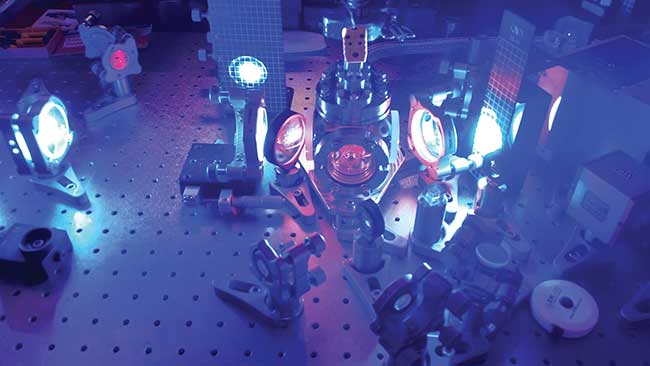
Direct diode pumping, shown here in a demonstration, promises to cut the cost of some ultrashort-
pulse-width lasers significantly. Courtesy of KMLabs.
Zhanwei Liu, an applied physics graduate student and lead author on the paper, noted that possible applications include metrology, micromachining, spectroscopy, nonlinear microscopy and more. “These areas need short duration and/or high peak power pulses. In addition, they have a strong demand for a low-price, compact and stable laser source. With further development, the Mamyshev oscillator may be a good solution,” he said.
He added that the group is working to scale up the energy to a microjoule or more. Liu also noted that research and development must address how to make the high-performance oscillator self-starting. Another area that must be tackled involves a better understanding of how the Mamyshev oscillator works and the nonlinear physics behind it.
Finally, for a look at where solid-state lasers may be headed, consider the work being done at the Lawrence Livermore National Laboratory’s (LLNL) National Ignition Facility & Photon Science (NIF) in Livermore, Calif. Its 192-beam, 351-nm light system replicates conditions found in nuclear explosions and other extreme states by concentrating all the beams on a target. Thus, it enables research into extreme conditions. The design also offers a way to potentially scale up power from the current 1.8 megajoules to that needed to initiate hydrogen fusion, according to the facility’s director, Mark Herrmann.
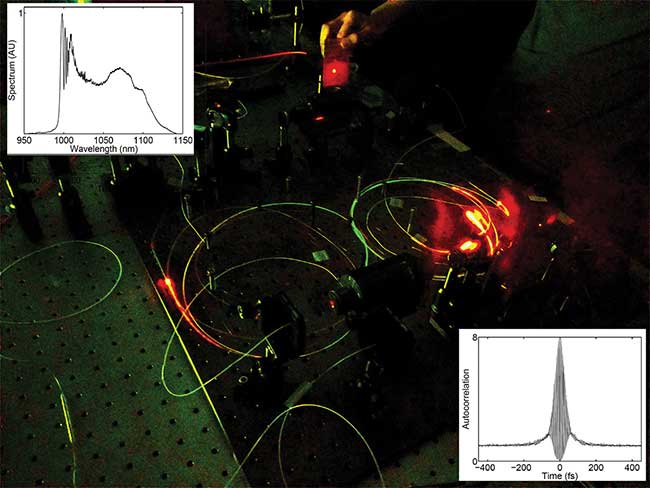
Ytterbium-doped fibers (lighted lines) of a new type of fiber laser are under investigation. The laser could prove useful in metrology, micromachining, spectroscopy and other areas that need short, high-power pulses in an inexpensive, compact and stable laser source. Courtesy of Zhanwei Liu, Cornell University.
The system uses flash lamps to pump the solid-state doped glass. Derivatives of the technology are finding uses elsewhere. At NIF, Constantin Haefner, program director for Advanced Photon Technologies, and his group recently delivered a high-repetition-rate, high-peak-power pulsed solid-state laser to the European Extreme Light Infrastructure facility in the Czech Republic.
A key advance that made this laser possible was a switch to using diodes for energizing the gain medium. In contrast to flash lamps, diodes pump close to the emission spectrum and therefore lessen the waste energy dumped into the system. Residual heat is removed with high-velocity helium gas streaming over the amplifier faces, a technology pioneered at LLNL. Exploiting these and other innovations, the group delivered a reliable petawatt, or 1015-watt, 10-pulse-per-second system.
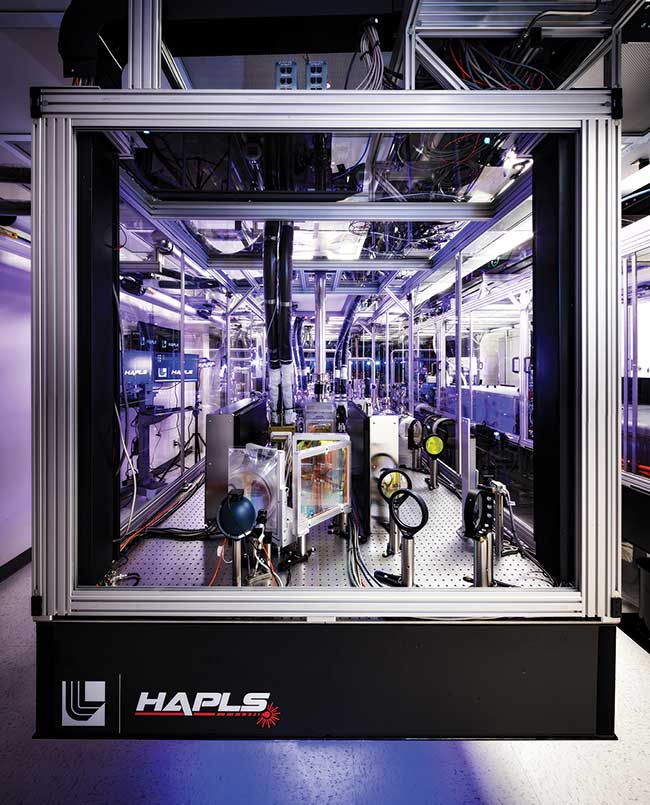
A petawatt, 10-Hz laser developed at Lawrence Livermore National Laboratory could form the basis for a rapid imaging system for industrial applications. Courtesy of Lawrence Livermore National Laboratory.
At those levels, the light that strikes a target can produce x-rays, neutrons or electrons that can be used for imaging, with the only thing needed being a change in the target. Today, such a capability requires access to an expensive and hard-to-schedule accelerator. In the future, a solid-state laser could enable this flexible and powerful imaging for rapid component analysis.
“On Monday, you can do x-rays. On Tuesday, you do the neutron radiography. On Wednesday, you know what the problem is and you can move on. It really accelerates the processing of material and making things and designing them,” Haefner said.
He added that engineering advances could be made in thermal management, the elimination of intermediate pumping states and elsewhere. These promise to increase the shot rate to hundreds of times a second while increasing the power and flux.
In summing up why new lasers and new imaging capabilities are needed, Haefner said, “The principles of design are completely changing with additive manufacturing and new materials. So, there is strong need to change how we’re doing metrology.”